Nerve Flossing: A Simple Guide to Reducing Nerve Pain
Most of the time, we don’t think about our nerves—until they start causing pain. Nerves are some of the toughest yet most sensitive tissues in our body. Often, we don’t notice symptoms until they become advanced.
The good news? If you recognize nerve pain early and have the right tools, you may be able to relieve pain at home and even avoid more serious issues like surgery.
What Do Nerves Do?
Nerves act as the body’s communication network, sending signals between the brain, spinal cord, and the rest of the body. They help us move, feel sensations, and regulate essential functions.
There are three types of nerves:
- Sensory Nerves – Carry signals from the skin, eyes, and ears to the brain.
- Motor Nerves – Control muscle movement and gland function.
- Mixed Nerves – Combine sensory and motor functions.
Why Are Nerves Important?
Your Nerves control:
✅ Sensation – Touch, temperature, and pain
✅ Movement – Voluntary and involuntary muscle control
✅ Autonomic Functions – Heart rate, digestion, and breathing
✅ Cognition – Thinking, memory, and reflexes
How Do Nerves Cause Pain?
When nerves are compressed, inflamed, or irritated, they send warning signals. At first, symptoms may be mild, but over time, they can progress.
Stages of Nerve Pain Progression
🔹 Mild Irritation (Early Stage) – Tingling, pins and needles, or mild numbness (like when your foot falls asleep).
🔹 Moderate Irritation (Intermediate Stage) – Burning pain, more frequent numbness, and potential muscle weakness. Examples: Carpal tunnel, tension headaches, mild sciatica.
🔹 Severe Pressure (Advanced Stage) – Constant pain, muscle weakness, and sensory loss. Examples: Disc herniation, spinal cord injuries, concussions.
What Triggers Nerve Pain?
- Prolonged pressure on a nerve
- Injuries like sprains or herniated discs
- Inflammation or underlying conditions (diabetes, autoimmune diseases)
- Nerve damage from trauma or repetitive strain
🚨 Warning Signs You Should See a Doctor:
- Sharp, shooting pain that won’t go away
- Muscle weakness or difficulty moving
- Pain that radiates down your arm or leg
How to Relieve Nerve Pain at Home
One of the most effective, research-backed methods is nerve flossing (also called neurodynamics). This technique helps move the nerve through its natural pathways, reducing pressure and irritation.
🔹 Studies show that nerve flossing can:
✅ Reduce pain levels by up to 2 points on a pain scale
✅ Increase flexibility and mobility
✅ Reduce joint and tendon pain
Key Tips for Nerve Flossing
🚫 Do NOT stretch too hard! Unlike regular stretching, nerve flossing should be gentle and controlled.
✔️ Stop at a mild tension level (no more than 4/10 discomfort)
✔️ No holding the stretch—move fluidly through each rep
✔️ More sessions = better results (repeat throughout the day)
Nerve Flossing Exercises for Pain Relief
Upper Body Nerve Flossing
🟢 Median Nerve (Wrist & Hand Pain, Carpal Tunnel)
1️⃣ Extend your affected arm out as if holding a tray.
2️⃣ Slowly straighten your arm while keeping your wrist extended.
3️⃣ Tilt your head away from your arm.
4️⃣ Move back and forth in one smooth motion.
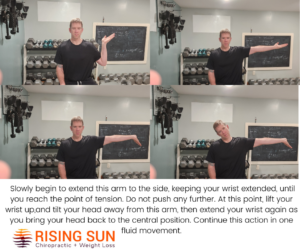
🟢 Ulnar Nerve (Elbow & Hand Numbness, “Funny Bone” Pain)
1️⃣ Make an “OK” sign with your thumb and index finger.
2️⃣ Hold your hand by your ear and rotate your fingers away from you.
3️⃣ Move your elbow outward while tilting your head away.
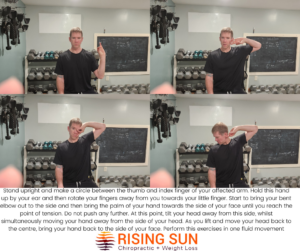
🟢 Radial Nerve (Forearm & Shoulder Pain)
1️⃣ Stand with your arm by your side, pinching your thumb and fingers together.
2️⃣ Curl your wrist inward and extend your arm behind you.
3️⃣ Tilt your head down and away from your arm, then return to the center.
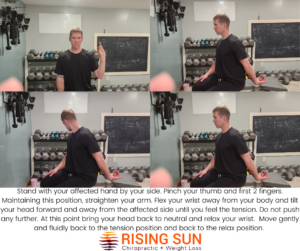
Lower Body Nerve Flossing
🟢 Femoral Nerve (Thigh & Hip Pain)
1️⃣ Lie face-down, resting your forehead on your hands.
2️⃣ Bend your knee toward your buttocks until you feel mild tension.
3️⃣ Lower your leg slightly while lifting your head.
4️⃣ Move fluidly between these two positions.
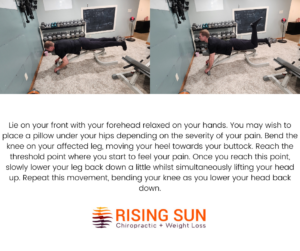
🟢 Sciatic Nerve (Lower Back & Leg Pain, Sciatica Relief)
1️⃣ Sit in a chair and round your back slightly.
2️⃣ Straighten your leg until you feel tension.
3️⃣ As you hold this position, raise your head and flex your foot upward.
4️⃣ Return to the starting position.
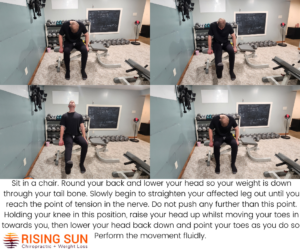
🟢 Posterior Tibial Nerve (Foot & Heel Pain, Plantar Fasciitis)
1️⃣ Lie on your back with one leg bent.
2️⃣ Straighten your knee while pulling your toes toward you and rotating your foot outward.
3️⃣ Lower your leg slightly while lifting your head.
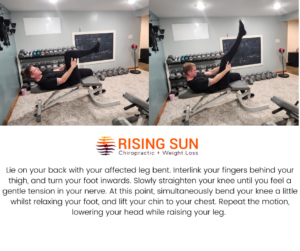
Get Lasting Relief from Nerve Pain
Nerve flossing is a safe, simple way to relieve pain and prevent further irritation. However, if your pain persists or worsens, it’s time for expert care.
📍 Need professional help? At Rising Sun Chiropractic + Weight Loss in St. Peter, MN, we specialize in nerve pain relief, chiropractic care, and rehabilitation. Check it out here!
💡 Book an appointment today! Call us at 507-934-3333 or schedule online here: risingsunchiro.janeapp.com
